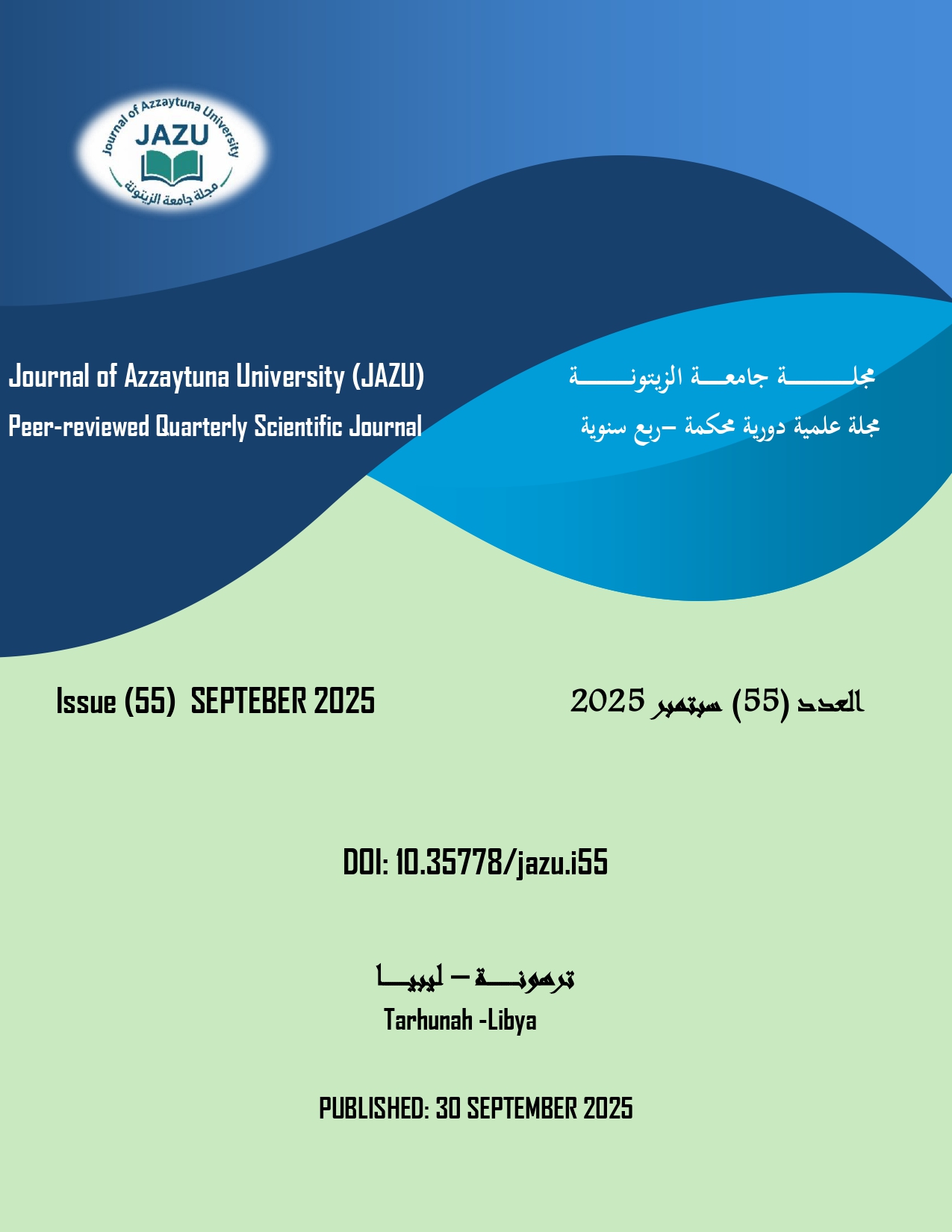جريمة الاشتباه في التشريع الليبي "دراسة تحليلية في ضوء القانون رقم (1) لسنة 1955 بشأن المتشردين والمشتبه في أمرهم "
DOI:
https://doi.org/10.35778/jazu.i55.a558Keywords:
Suspicion, Criminal Dangerousness, Warning, Police Surveillance, DetentionAbstract
This study aims to clarify the concept of the offense of suspicion and the rationale behind its criminalization. Suspicion, as an offense, can be described as anomalous, as it is not based on a specific act or behaviour, but rather on a particular characteristic inferred from certain crimes in which a person has previously been convicted or seriously accused. More strikingly, these crimes are often devoid of any discernible intent or motive. This renders the criminalization of suspicion particularly unusual and raises questions about its legislative coherence—or, more precisely, its legal ambiguity. Suspicion does not conform to any of the primary standards established in legal theory. In this context, an individual is not punished for a particular act committed, but rather for a moral or character trait attributed to them. This represents a clear deviation from established legal norms, which require that criminal liability be based on a specific, identifiable act. The principle underlying the criminalization of suspicion is grounded in the interest of public safety. In certain cases, it may be deemed necessary to impose limited restrictions on the liberty of a small segment of society when there is a perceived threat stemming from that group. Such a threat may arise from repeated convictions for offenses or from a reputation for criminal behaviour, where a person’s lifestyle is pervaded by unlawful activity. The justification for this form of criminalization lies in the potential risk of future criminal conduct, especially when dealing with individuals considered inherently dangerous—such as the suspected person—whose way of life is itself deemed hazardous. The aim is to protect both the individual and society by preventing potential crimes, even in the absence of any formal conviction, provided that the person is widely known for engaging in such criminal behaviour.
Therefore, the offense of suspicion may be classified as a form of preventive security measure, whereby the legislature seeks to proactively guard against the harm posed by individuals with known criminal tendencies. Those who are habitually involved in or widely suspected of certain criminal acts may be more likely than others to commit offenses in secret. As such, their forced exclusion from the criminal environment becomes a necessary measure, compelled by the public interest. It would be reckless to allow such individuals to act freely without any safeguards, given the threat they pose to society.
Downloads
References
أولاً ـ الكتب:
أـ الكتب العامة:
1-عبد الملك. جندي (1926)، مجموعة المبادئ الجنائية، دار المنشورات القانونية، بيروت، لبنان، الطبعة الثانية.
2- بهنام. رمسيس (1977)،نظرية التجريم في القانون الجنائي ، منشأة المعارف، الاسكندرية.
3-بهنام. رمسيس (1988)، المجرم تكويناً وتقويماً ، منشأة المعارف، الإسكندرية.
ب ـ الكتب المتخصصة:
1 ـ جاد. حسن، التشريع المصري للمتشردين والمشتبه فيهم ومراقبة البوليس (1930) دار الكتب المصرية، الطبعة الاولى، القاهرة.
2 ـ عبيد. رؤوف، شرح قانون العقوبات التكميلي (1965)، دار الفكر العربي، القاهرة.
3 ـ محمد. عوض، قانون العقوبات التكميلي (1960)، المكتب المصري الحديث للطباعة والنشر، الطبعة الاولى، الإسكندرية.
4 ـ أهليل. فرج علواني، الوجيز في قوانين الاشتباه والتشرد والمراقبة القضائية والاسلحة والذخائر (1987).
5ـ بكري. محمد عزمي، جرائم التشرد والاشتباه في القانون المصري، المكتبة القومية الحديثة (1978)، الطبعة الاولى، طنطا.
6 ـ يوسف. محمد اسماعيل، جريمة الشيك وتبديد المحجوزات وجرائم التشرد والاشتباه (1966)، جامعة الاسكندرية.
7ـ عبد التواب. معوض، الوسيط في شرح قانون الاسلحة والذخائر والتشرد والاشتباه، منشأة المعارف (بدون سنة نشر)، الاسكندرية.
ثانياً ـ لرسائل العلمية:
أ ـ أطروحات دكتوراه:
1ـ الالفي. أحمد عبد العزيز، (1965) العود الي الجريمة والاعتياد على الاجرام، اطروحة دكتوراه منشورة المطبعة العالمية، القاهرة.
2 ـ الجمال. محمد علي (1988)، التشرد والاشتباه، أطروحة دكتوراه منشورة ، أكاديمية الشرطة، كلية الدراسات العليا، القاهرة.
ثالثاً ـ المدونات والمجموعات التشريعية:
1 ـ قانون رقم 1 لسنة 1955 بشأن المتشردين والمشتبه في امرهم.
2 ـ قانون رقم 98 لسنة 1945 المصري بشأن المتشردين والمشتبه في امرهم.
3 ـ قانون تنظيم الوضع تحت مراقبة الشرطة.
4 ـ مجموعة التشريعات الجنائية، الجزء الاول، العقوبات، إعداد الإدارة العامة للقانون، سنة 1986.
5 ـ مجموعة التشريعات الجنائية، الجزء الثاني، اجراءات جنائية، اعداد الادارة العامة للقانون، سنة 1987.
رابعاًـ الأحكام القضائية:
1 ـ أحكام المحكمة العليا الليبية، المكتب الفني، طرابلس.
2 ـ أحكام محاكم النقض الفرنسية (case Crim ).
3 ـ مجموعة أحكام النقض المصرية، المكتبة الفنية القاهرة.
4 ـ مجموعة المبادئ القانونية التي أقرتها محكمة النقض في مصر، الدائرة الجنائية.
5 ـ المدونة الجنائية للقواعد القانونية التي قررتها محكمة النقض المصرية واصدرها المكتب الفني.
خامساً ـ مراجع اخرى:
أ ـ المعاجم اللغوية:
1 ـ ابن منظور. محمد بن مكرم بن علي بن أحمد بن القاسم بن حقبة (بدون سنة نشر)، لسان العرب، دار المعارف، القاهرة الجزء الرابع.





